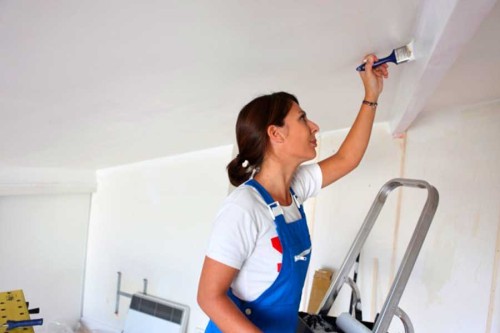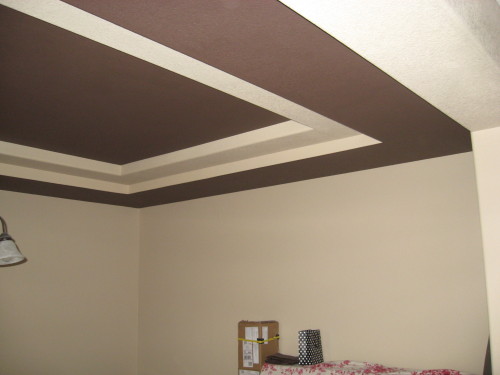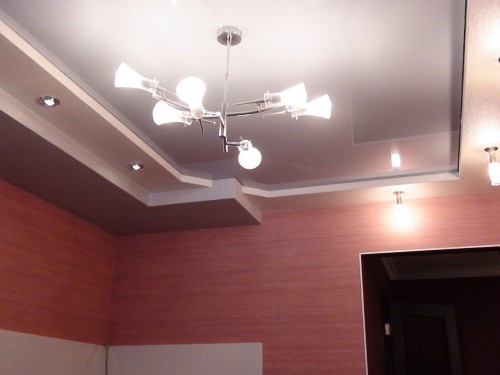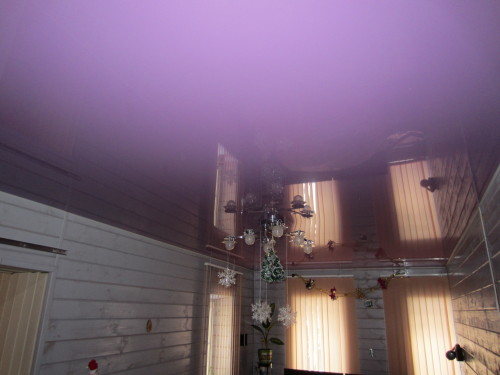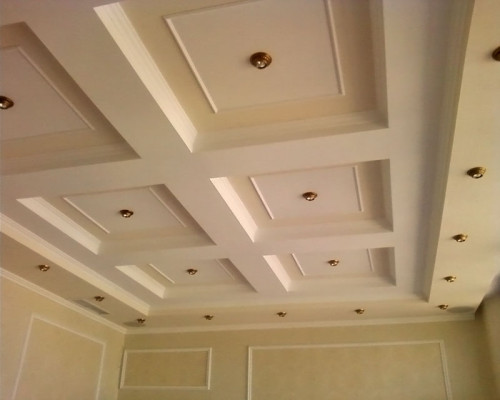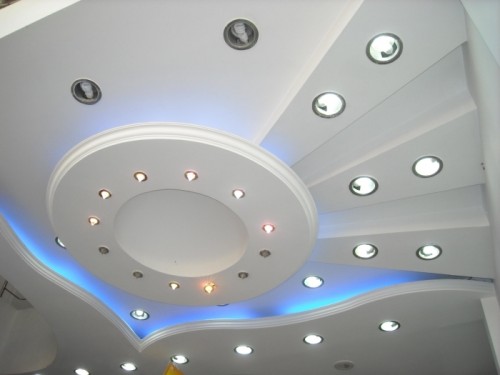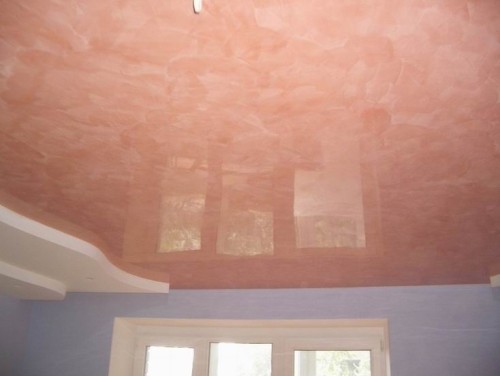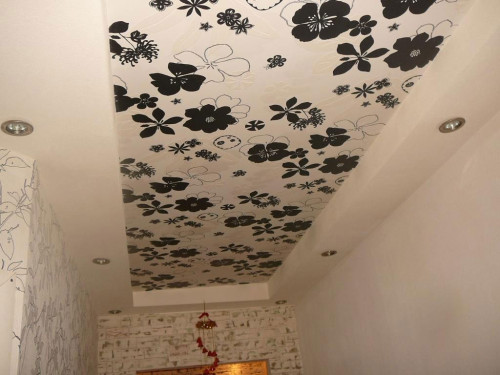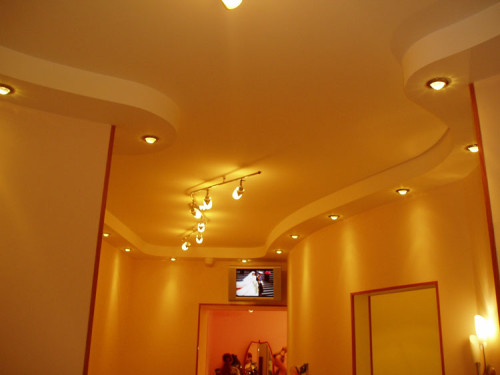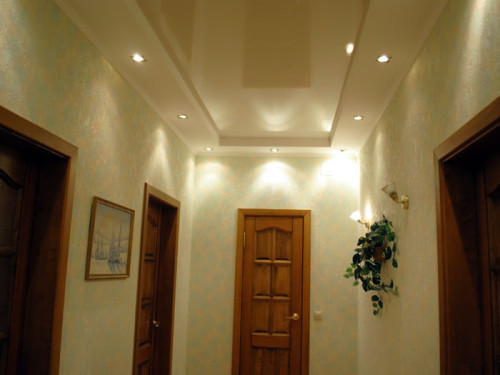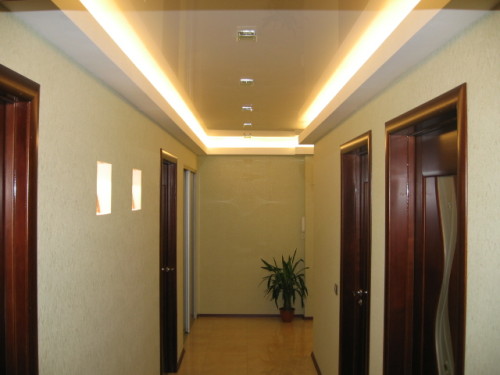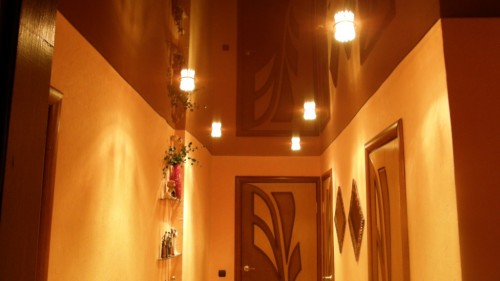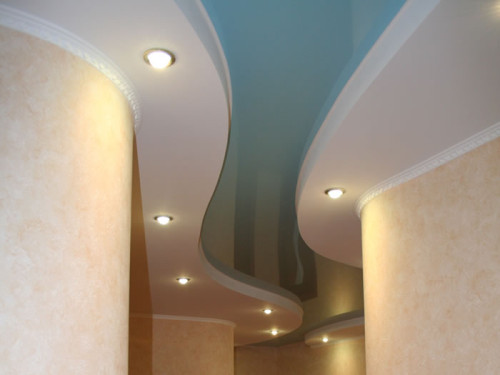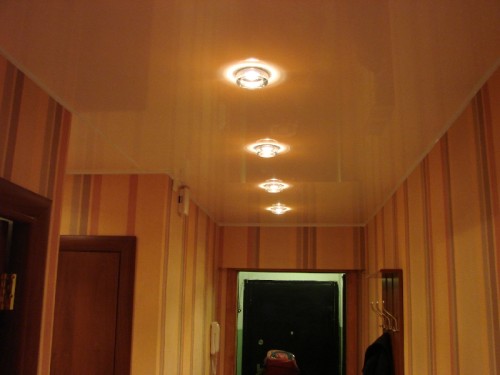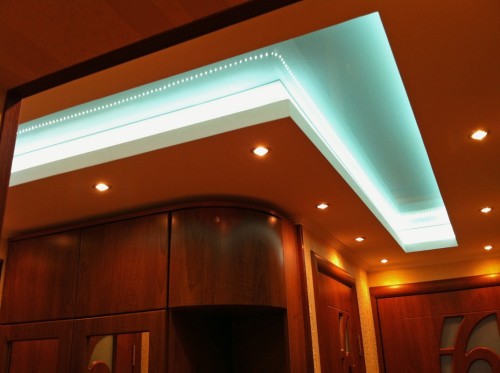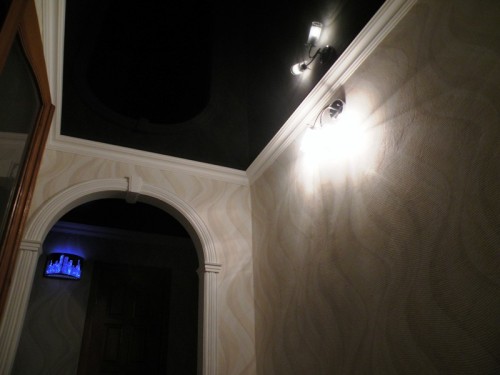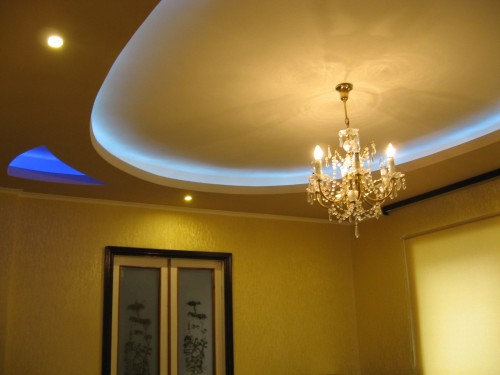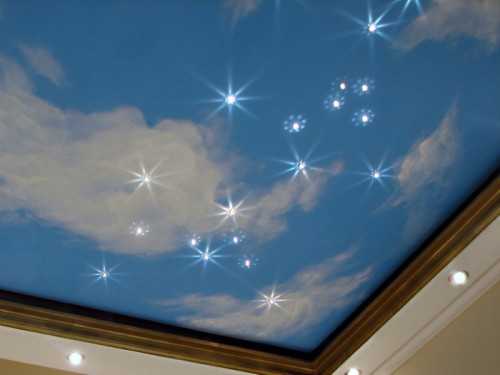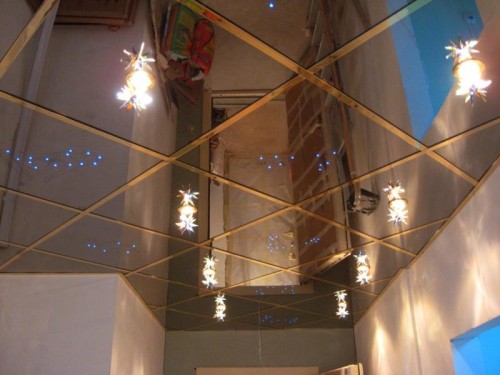
Ceiling in the hallway: photo, ideas Ceilings
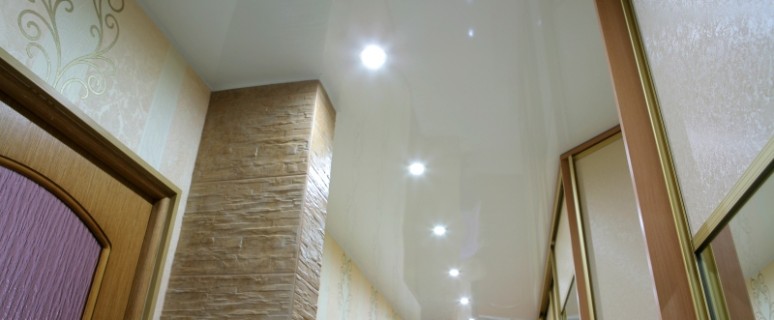
The design of the ceiling in the hallway often pays undeservedly little attention. Meanwhile, it is this room that is an apartment business card. Turning to this room for the first time, the guest is the impression of the dwelling as a whole, which is why it is worth taking care of creating a beauty and a cozy atmosphere in the hallway.
Content
Simple and inexpensive ways to finish the ceiling in the hallway
Poles the ceiling
The most affordable and labor costs for designing the ceiling is considered to be. Not everyone agrees to resort to such a simple and old-fashioned method, preferring to him more beautiful, unusual and stylish options. However, those whose financial capabilities are limited, such a finish will help to give the ceiling, though unassuming, but a very neat and tidy look. It takes quite a bit for the work: the surface should be placed if it has not been done earlier, then the ceiling must be thoroughly aligned and cheer. Even a person who has no experience in construction and repair will easily cope with such work.
Coloring of the surface
As simple as an embodiment, but more interesting in terms of the final result, the method of finishing the ceiling is its painting. As a working material, you can choose both ordinary interior paints and textural formulations that, after drying, form an original texture on the surface.
Choosing painting as a way to decorate the room, you need, first of all, to determine what will be the color of the ceiling in your hallway. Fortunately, the modern building market offers the choice of buyers the widest range of dyes, among the rich palette is easy to choose the appropriate option. But even if among this diversity there is no need to be shade, the colorist specialists mix multiple colors to achieve the desired result. Selecting the material for work, you need to rely on the total color design of the room. The ceiling in the hallway can be performed in the same color range with a room, and it can be contrasted favorably, with the other elements of the finish.
When staining the ceiling it is important to understand that such a finishing material not only does not hide the shortcomings of the surface, but also emphasize the flaws. Therefore, an important preparatory stage before painting is the leveling of the ceiling to almost the perfect state. In case the surface is smooth, smooth and uniform, it will look great in the painted form.
Ceiling design in the hallway, photo:
Decoration of ceilings with decorative plaster
Popular to date, the option of finishing the premises is considered to be plastered by their decorative compositions. This work will have to spend more time and forces than in the cases described above, but the final result will cost these efforts.
Decorative plaster is always applied as the finish layer on top of the starting plaster composition. Using various tools and surface fixtures, you can give an unusual texture, perform any drawing, ornament, etc. There are also plaster mixtures that include various fillers. These particles form a relief of the surface after drying the plaster. By the way, in contrast to the painting of the ceiling, when finishing his decorative plaster there is no need to level the starting layer to the perfect state - it simplifies the work noticeably.
The plaster mixture can be applied, that is, painted at the stage of mixing components, and may have white color and staining already on the treated surface after drying. By the way, painting decorative plaster gives an additional opportunity to implement a variety of design ideas. The embossed surface can be colored one tone, and you can use several contrasting shades to emphasize the depth of the pattern and the protruding parts of the relief.
Ceiling pasting in the hallway wallpaper
A relatively cheap option for designing the ceiling in the hallway is shook wallpaper. In modern stores, the assortment of this material is very wide, the same goes for the price range. In addition, thanks to the shade and specifics of the chosen wallpaper pattern, the disadvantages of the room layout can be hidden, for example, visually expand the space, visually make the ceiling higher or low. In the latter case, it will be enough for the ceiling and the walls of the same wallpaper.
PVC Tile surface finish
The ceiling in the hallway made from PVC panels is another available and fast way to finish the room. When placing a ceiling with such material, it is not necessary to worry about the perfect surface alignment, because the tile of polyvinyl chloride will hide small defects and level drops. In addition, the elements are large in the area glued to the ceiling fairly quickly, so repairs can be completed in the shortest possible time. PVC panels are quite diverse, they can imitate various textures and natural materials, possess beautiful relief, ornament or pattern. The disadvantages of plates from polyvinyl chloride can be attributed to low strength, water permeability, flammability, a tendency to pollution. But such an economical version will be quite suitable for people with a modest budget.
Suspended ceilings in the hallway
Ceiling of plasterboard
Plasterboard can be attributed to low-cost building materials, but despite the available cost, it has a lot of advantages, and also allows you to implement many design ideas. We will understand more about the positive qualities of the material:
- Plasterboard refers to environmentally friendly finish. It can be used indoors, because it does not have a bright-pronounced smell, does not contain harmful components and does not highlight toxins into the surrounding space.
- Plasterboard is quite moisture-resistant, and also fireproof. This non-combustible material will not create risks of fire, if you set it near electrical appliances.
- Lightweight material allows you to easily transport and not spend extra physical effort when working. Plasterboard sheets have a large format, so finishing is carried out in a short time.
- Plasterboard can be given almost any forms, cutting it into parts, bending at different angles, etc. This makes it possible to embody many designer ideas into reality.
- By placing the ceiling with plasterboard, it is possible not to take care of the particularly thorough preparation of the surface, since the dense sheets of the material will hide any defects. By the way, various wires and cords are also easy to disguise with drywall.
- The sheets of material are interchangeable - this suggests that if any fragment is damaged, there is no need to change the entire cladding, it is enough to simply install a new sheet into place of the broken.
- Plasterboard has a smooth and smooth surface that can be easily painted or caught with wallpaper.
- From such a material, you can perform original and interesting multi-level ceilings, equipped with practically any kind of lamps.
- Plasterboard stands relatively inexpensively, such a type of finish can afford people with average sufficiency.
By cons of such a material, it is possible to attribute it to its use in premises with low ceilings, because when creating a ceiling of plasterboard, a frame is used in the hallway, which steals several centimeters of space.
All ceilings made of drywall can be divided into 2 large groups:
- A single-level ceiling is a simple uncomplicated design that allows you to hide the irregularities and disadvantages of the surface by making it almost perfect. Ordinary single-level ceiling can be additionally decorated with wallpaper or interior paint, and the correct location of the lighting points will give the room an interesting view.
- The multi-level ceiling is a more complex design. Experimenting with levels, shapes and lamps, you can make such a ceiling by a real work of art. The backlight in this case plays one of the most important roles, because correctly located light sources often perform not only decorative, but also practical functions. For example, a ceiling in a narrow hallway can be visually wider with the help of lamps. When creating multi-level ceilings, designers can play not only with the location of the rays, but also with their tint. The plasterboard ceiling is also good because it allows you to install several point lamps as the main lighting. This is especially true for low premises, where it is often not possible to hang a chandelier.
Stretch ceiling in the hallway
Those who do not want to save on the design of their apartment can be advised by one of the most expensive, but also the most beautiful finishes - stretch ceiling. Such a ceiling is a suspension design, and this is due to one of its advantages - the absence of the need to prepare the surface under the decoration. The perfectly smooth and even film disguises absolutely all flaws, ranging from small cracks and ending with noticeable level drops.
Stretch ceilings always look neatly, stylish, beautiful and expensive. Film manufactured to order can have a variety of colors and shades, mimic such surfaces like wood, leather, ceramics, etc. With the help of thermal printing on the film, various pictures, pictures, photos can be applied. Due to these features, the stretch ceiling will fit into any design hallway.
Lovers of classicism will probably enjoy the stretch ceiling with a fresco - this option looks stylish, exquisitely, prestigious and elegant. However, more simple finishes will look no worse, especially if it is advantageous to beat them with the help of correctly located backlight.
By the way, the film that is used for the stretch ceiling is rather durable and waterproof. Even if the neighbors flood the neighbors from above, the new repairs and furniture does not threaten anything. Water that keeps the stretch ceiling can be subsequently drained.
Important: Installing the stretch ceiling - the process is quite complex and requires the involvement of specialists. It is better not to try to mount the design with your own hands, but to resort to the help of professionals, in the arsenal of which there are special tools and devices, as well as the necessary experience.
It should be noted that the stretch ceiling is perfectly combined with a suspended design of plasterboard.
Stretch ceilings in the hallway, photo:
Modular suspended ceilings
Another type of suspended structures are modular ceilings. They are performed from special plates, cassettes or rails installed on a pre-mounted frame. Consider in more detail several types of modular structures:
- The tile ceiling is bursting with plates made from different materials. A similar ceiling in the hallway can be plastic or gypsum, made of polystyrene foam or mineral fiber. The standard size of the plates, as a rule, is 60x60 cm, but curved figures that are used in various three-dimensional structures can be found on sale. The ceiling elements are attached to a special framework consisting of carrier profiles and suspensions. The framework itself can be invisible or visible. In the first case, the fasteners are completely hidden under the sheets of finishing material, in the second case, the edges of the island shared the plates.
- There is also a type of modular ceilings as Grilyato. Such modules are made in the form of metal grilles. This type of finish will look good in the office, but for a residential building or apartment, he is unlikely to suit.
- Rack ceiling is performed from aluminum rails, opened with color enamel or varnish. Rakes are also mounted on a pre-installed frame. Among the advantages of such a finish can be distinguished moisture resistance, fire safety, ease of care. The cam ceiling looks neatly, it can be additionally decorated with built-in light sources. By the way, the rails themselves are represented in various color versions, and you can even make specially curved details to order, to make the original multi-level ceiling.
Ceiling in the hallway, photo:




